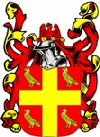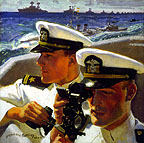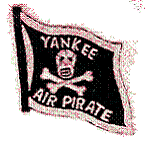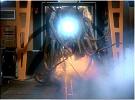treespider
Posts: 9796
Joined: 1/30/2005
From: Edgewater, MD
Status: offline

|
The Shock of Hiroshima
Tristan Grunow
University of Oregon
Japanese Atomic Bomb Projects
Unlike the American Manhattan Project, which was initiated by civilian
scientists and then supported by the military, the Japanese atomic programs
were started by military officers who then sought out the expertise
of scientists.5 The Japanese military actually conducted three entirely
separate atomic programs in the course of the Pacific War: one by the
Army code-named “Ni-go,” and two by the Navy, first the “B-research”
program and second the “F-go” project.
The Army’s “Ni-go” Project
In April 1940, Lieutenant-General Yasuda Takeo, director of the Army
Aeronautical Department’s Technological Research Institute, ordered
Lieutenant-Colonel Suzuki Tatsusaburo of the Army Aeronautical Department
to investigate the possibility of building an atomic bomb.6
Suzuki consulted with his former Tokyo Imperial University physics
professor, Sagane Ryokichi, and reported to Yasuda in October of the
same year that the Japanese empire contained enough uranium ore to
produce atomic weapons.7 Yet the Army was slow to act on this information.
It was not until April 1941 that Yasuda ordered Suzuki to contact
Okochi Masatoshi, head of the Institute of Physical and Chemical Research
(Riken) in Tokyo, and consult with him about establishing a
nuclear program. Okochi referred Yasuda to a scientist at the Riken,
Nishina Yoshio.8
Nishina, who was the leading Japanese physicist of his day, had
studied under Ernest Rutherford at the Cavendish Laboratory in Cambridge,
England, and under Niels Bohr, the most prominent nuclear scientist
of his time, in Copenhagen, Denmark.9 At the time he was
approached by Yasuda, Nishina was in the middle of completing a 60-
inch cyclotron at the Riken, and saw the atomic bomb program as a
means to earn military financial support for his own research.10 With
this in mind, Nishina joined the program and began researching atomic
energy, in turn ordering Takeuchi Masa, a scientist at the Riken, to begin
researching an atomic bomb on 22 December 1942.11
The project received official sanction in early 1941 from Tojo Hideki,
then serving as Army minister, who proved exceptionally prescient in
his recognition of the potential importance of atomic weapons in determining
the outcome of the war.12 However, because Japanese forces were
winning the war at first, there was no initial sense of urgency about
atomic research.13 In addition, Nishina and his staff were not given much
financial or technical support. All this began to change after the Japanese
defeat at Midway on 6 June 1942. Suddenly, the Japanese military
started looking for new weapons to turn the tide of the war. In March
1943, Yasuda updated then–Prime Minister To\jo\ on the progress of the
projects, which had been proceeding sluggishly.
The slow progress of the Japanese projects, and rumors that the United
States and Germany had started similar projects, led Tojo to express
concern about Japanese atomic research at a Cabinet meeting held in
early spring 1943 at the War Ministry.14 During this Cabinet meeting,
To\jo\ stated that if Japan fell behind the United States in atomic science,
they would lose the war.15 In response to To\jo\’s argument, the Cabinet
issued two new directives to accelerate scientific research, the “Outline
of Urgent Measures for Scientific Research” and the “Comprehensive
Policy for the Mobilization of Science and Technology.”16 The first directive
was conceived in August 1943, and created a Research Mobilization
Committee to regulate research for the war effort. In October 1943, the
Cabinet reconfigured the committee as the Research Mobilization Council.
Finally, in November 1943, the second directive, the “Comprehensive
Policy for the Mobilization of Science and Technology,” gave priority
to aeronautic research and the development and production of new scientific
weapons.17 In addition to these two directives, To\jo\ ordered the
bomb projects to be accelerated, and commanded Major Generals
Kawashima Toranosuke and Taniguchi Hatsuzo\ to meet with Nishina
and promise him all of the supplies and finances that he needed. Yasuda
appointed Kawashima as the military liaison to Nishina, and in May
1943, upgraded Nishina’s research program into an official Army program
code-named “Ni-go\,” after the first characters of Nishina’s name.18
The “Ni-go\” project was allocated a laboratory, designated Building 49,
at the Riken campus in Komagome, Tokyo.19
Takeuchi Masa, a scientist involved in “Ni-go\,” recalls that after the
program was officially recognized by the military, the program scientists
were required to put “confidential” at the top of their documents
and were reminded of the importance of their research to the war effort.20
However, “Ni-go\” continued to proceed slowly. The increasingly heavy
firebombings that started in 1945 convinced scientists at the Riken that
building a bomb was impossible under such conditions.21 Worse, on 13
April 1945, Building 49 was destroyed by fire in a bombing raid, ruining
much of Nishina’s experimental equipment.22 On 28 June 1945, beset by
all of these difficulties, Nishina reported to his Army superiors announcing
the cessation of atomic research, citing the difficulty of obtaining
enough weapons-grade uranium to produce a bomb, and stating that
since the United States would probably be suffering from the same difficulties,
there was no reason for continuing research.23 The Army Technical
Research Division then sent a three-article report to the Army
Ordinance Division, announcing that Nishina could not obtain enough
uranium to build a bomb and that the United States would not be able to
obtain enough uranium either.24 Army Minister Anami Korechika then
made the decision to officially terminate “Ni-go\” in June 1945.25
The Navy’s “B-Research” and “F-go\” Projects
As early as 1934, the Imperial Japanese Navy had sponsored an investigation
into the feasibility of producing a “super-weapon” based on
Enrico Fermi’s theories of atoms. Although this early investigation concluded
that an atomic weapon was not then feasible, the military paid
close attention to international developments in nuclear physics. The
Navy saw nuclear fission not only as the means to produce an atomic
bomb but also as a potential alternative fuel source for warships, and to
this end sponsored monthly lectures on nuclear physics by Osaka Imperial
University Professor Asada Tsunesaburo\ starting in 1937. These
lectures, conducted at the Navy Technical Research Institute and the
Navy Aeronautical Laboratory, continued until the outbreak of the war.26
Around the same time as the Army project was getting under way,
Captain Ito\ Yoj\ i, chief of the First Section of the Electronic Division of the
Navy Technical Research Institute, was also closely following international
developments in nuclear physics.27 In 1939, Ito\ had proposed the
idea of establishing a nuclear project to the institute, but it was not until
shortly before the Pearl Harbor attack in December 1941 that he initiated
a feasibility study.28 Like Suzuki of the Army before him, Ito\ consulted
with Professors Sagane Ryo\kichi and Hino Juichi.29 Ito\’s report, entitled
“Atomic Physics Application Research,” stated that the U.S. military
was probably already conducting research on atomic energy in cooperation
with Jewish refugee scientists from Germany.30 The report, therefore,
suggested that the Japanese military also begin a program, and cited
atomic energy as a promising source of fuel for ships, but did not specifically
mention the development of a nuclear bomb. The Navy saw promise
in the project and authorized research in four sections. The Navy
code-named the section concerning atomic bombs “B-Research,” and
established the Physics Committee to conduct preliminary studies of
nuclear energy. The Navy, like the Army, looked to Nishina Yoshio to
chair the committee.31
Research, however, did not begin until after the Battle of Midway in
1942, when the Commander in Chief of the Imperial Navy Yamamoto
Isoroku ordered the production of “epoch-making” weapons—including
atomic weapons, radar, and the “death ray.”32 The Navy’s Physics
Committee met for the first time on 8 July 1942 at the Suikosha officers’
quarters in Shiba Park in Tokyo.33 In addition to Ito \ and Nishina, some of
the nation’s leading physicists attended, including Sagane Ryok\ ichi and
Asada Tsunesaburo.\ 34 Ito \ asked the scientists two main questions: would
Japan be able to produce a bomb?, and could they do it before the United
States or Great Britain? In response, Sagane stated that a bomb would
take years for Japan to build.35 During these meetings, perhaps due to his
commitment to confidentiality concerning the Army’s “Ni-go\” project,
Nishina remained silent.36 The committee, which was made up of the
“best minds in Japan,” met for the last time on 6 March 1943, at which
time the scientists informed the military that, although producing a bomb
was theoretically possible, they doubted whether Japan could produce
one in time for use in the war.37 Furthermore, they expressed doubt that
any country, including the United States or Great Britain, would be able
to produce an atomic bomb.38
While Ito\ was forming the Physics Committee under the Navy Technical
Research Institute, Lieutenant-Commander Murata Tsutomu came
across an article entitled “America’s Super Bomb,” in the German science
journal Nitrocellulose. Murata made a translation of the article and
distributed it to other departments in the Navy.39 The article fell into the
hands of Captains Iso Megumu and Mitsui Matao of the Bureau of Ships’
Artillery and Explosives Division, who consulted with Kyoto Imperial
University Professor Arakatsu Bunsaku about the feasibility of an atomic
weapon.40 Arakatsu agreed to start researching a nuclear bomb under
the authority of the Bureau of Ships, although he was skeptical. “Theoretically
speaking, an atomic bomb is possible, but in reality I’m not
sure,” he responded to the order to start research, “It’d be good if we
could get hold of a lot of uranium, but for now we’ll just research the
possibility [of a bomb], that good enough?”41 When Arakatsu finally did
start a research program, he did so, as he later stated, largely to save
young scientists from being drafted into the military.42
After Ito\ disbanded the Physics Committee in March 1943, the only
remaining Navy nuclear weapons project was the Bureau of Ships project
led by Arakatsu in Kyoto. In May 1943, the Bureau of Ships increased
financial support for Arakatsu’s program, and officially designated it
the “F-go\” project.43 The scientists involved with “F-go\” held their first
and only formal meeting with their Navy sponsors on 21 July 1945 at a
hotel on Lake Biwa near Kyoto.44 During this meeting, two Navy officers
reported that no uranium was then available for research purposes.45
The scientists in turn informed the Navy that while a bomb was theoretically
possible, it could not be produced in time for the war.46
Ramifications of the Failed Japanese Projects
With the dissolution of the “F-go\” project, all three of Japan’s atomic
programs had come to an unsuccessful end by the close of July 1945. On
three separate occasions, Japan’s top scientists had informed the military
that neither Japan nor the United States would be able to produce an
atomic weapon before the end of the war. These repeated failures—of the
Physics Committee in 1943, of the Army’s “Ni-go\” program, and the
Navy’s “F-go\” project in 1945—combined to convince the Japanese military
that atomic bombs could not be developed in time for use during the
war. Moreover, they instilled within the Japanese military a false sense
of immunity to the threat of atomic weapons, as Japanese scientists, extrapolating
from their own failures, concluded that other nations’ endeavors
to construct atomic weapons would also end in failure.
That high-ranking military officers were well informed and aware of
the lack of progress of the atomic weapons projects is evident from their
involvement in the sanctioning and decision-making processes of the
projects. To\jo \Hideki and Anami Korechika, the two most powerful military
men in the country during their respective terms as Army minister,
were part of official sanctioning of the Army project in 1941 and also the
decision to terminate it in 1945. Anami also served as the Chief of the
Army Aeronautical Division, under whose authority the “Ni-go\” project
was carried out, from 1944 until his appointment as Army minister in
April 1945. While To\jo\ was prime minister, he even corresponded personally
with Nishina to discuss the progress of the program and was
disappointed when he learned the project had not proceeded very far.47
Other high-ranking military officers, including Lieutenant-General
Kawabe Torashiro\ and the members of the Army General Staff, were kept
up-to-date on the difficulties faced by each of the programs.48
___________________
Conclusion: The Shock of Hiroshima
In the final days of the war, the Japanese military, especially Army Minister
Anami Korechika, steadfastly denied that the bomb dropped on
Hiroshima was atomic. The military’s denial was a direct result of their
false convictions that atomic weapons could not be produced by any
country in time for use during the war. These convictions arose from the
failure of Japan’s own atomic ambitions under Nishina’s Army “Ni-go”\
project, and the Navy’s “B-research” and “F-go\” projects under Arakatsu
Bunsaku. The failure of these projects and, most notably, the scientists’
insistence that development of an atomic weapon was nothing short of
impossible during the current war, reassured the military in the face of
Hiroshima that there was no genuine threat from atomic weapons. Put
together, all of these factors served to delay the surrender of Japan until
after the Soviet invasion of Manchuria and the bombing of Nagasaki,
needlessly resulting in hundreds of thousands of casualties. Anami’s
statements during the Cabinet meeting on 7 August explicitly illustrate
the false convictions of the military. “Is it not a matter of common knowledge
among Japanese physicists,” he questioned rhetorically, “that it
will take several more years before an atomic bomb can be developed?”208
“Any such move [for peace],” Anami continued, “is uncalled for, we do
not yet know if the bomb was atomic. Until the investigation reports are
received, we must not take any impetuous action.”209
While they were waiting for the final report of the Arisue Investigation
Team in Hiroshima, Japan’s military leaders argued that the nation
should not surrender because they remained confident in Ketsu-Go.\ Furthermore,
the military maintained that the Hiroshima bomb did not pose
an insurmountable threat to the country. Not until the submission of the
Hiroshima Bombing Investigation Report on 10 August did the government
and military leaders know for sure that the Hiroshima bomb was
atomic. Even then, conflicting reports continued to contest this claim,
thus leaving some doubt in the minds of the military leaders. At this
point, however, the leaders succumbed to the emperor’s desire for peace.
As Vice Chief of the Army General Staff Kawabe Torashiro\ wrote in his
diary after being informed of the emperor’s decision: “Alas, everything
is over.”210 The Army now sought a way to abide by the emperor’s will
while at the same time retaining “face.” This led them to concede that,
while they had not been fully defeated militarily, they had lost a “scientific
war.”
Although it is the military that was ultimately responsible for Japan’s
delayed surrender, the Japanese atomic scientists, who so assuredly informed
the Japanese military leaders that atomic weapons would not be
developed during the war, must shoulder some of the blame. Yet, Japanese
atomic scientists have largely escaped criticism for their wartime
actions and their roles in the delayed surrender. As Keiko Nagase-Reimer,
Walker Grunden, and Yamazaki Masakatsu have pointed out, “The Japanese
scientists involved in wartime nuclear research were not strongly
criticized by the Allied scientists for their cooperation with the military
during the war.” In fact, because the atomic bombings of Hiroshima and
Nagasaki have become “a symbol of the Japanese defeat” and the “ultimate
symbol of the suffering of Japanese people during the war,” the
Japanese people, along with the atomic scientists, have all come to be
seen as victims of the war. And indeed, they see themselves as victims,
too. “Even nuclear victims were not inclined to criticize these scientists’
involvement in nuclear projects during the war.”211
One critic who has spoken out against the Japanese atomic scientists
is Yamamoto Yo\ichi, of the 8th Army Research Division associated with
the “Ni-go\” project. Yamamoto has argued that the blame for the tragedies
of Hiroshima and Nagasaki rests solely on the scientists, because
they did not “fear” the bomb, and did not believe that the United States
could produce one.212 Yamamoto argues:
If the Japanese scientists’ thinking that production of atomic bombs was
not presently possible had not led them to deny as a rumor the American
announcement [the Potsdam Declaration] that the United States had
completed the bomb, Hiroshima and Nagasaki would not have been
bombed. The regrettable thing is, we then have no excuses for the victims
of Hiroshima and Nagasaki. If the scientists knew the dreadfulness
of the atomic bomb, simply because of the completion of the atomic
bomb, would there not have been an effort to take a step toward ending
the war?213
In addition, Yamamoto argues that the scientists had a moral responsibility
to alert the Army to how destructive an atomic bomb could be.
Kawabe Torashiro\’s postwar interrogation corroborates this opinion.
“Actually, [the] majority in the Army did not realize at first that what
had been dropped was an atomic bomb,” Kawabe stated, “and they
were not generally familiar with the terrible nature of the atomic bomb.”214
Had the scientists alerted the military about the power of atomic bombs,
the response to the Potsdam Declaration would have been different.
However, because the scientists did not believe a bomb was possible,
they did not warn the military. Thus Yamamoto contends that the scientists
’ mentality—”if Japan could not produce a bomb, then neither could
the United States”—actually caused the bombings of Hiroshima and
Nagasaki.215
Obviously, there was no initial consensus among Japanese scientists
that the Hiroshima bomb was atomic. Moreover, had the scientists immediately
acknowledged that the Hiroshima bomb was atomic, the Army
could possibly still have opted for a decisive homeland battle. As the
Army Military Affairs Bureau’s report to the National Diet suggests, the
atomic bombs would not have caused a change in Ketsu-Go\ plans. Yet,
since the scientists exacerbated the entrenched obstinacy of Japan’s
myopic leadership by assuring that atomic weapons would not, and
could not, be developed during the war, their dilatory influence should
certainly be factored into any discussion of the delayed Japanese surrender.
Had the military not been falsely led to believe that atomic weapons
were not a genuine threat during the war, they would have responded
much differently to the bombing of Hiroshima. If, in the wake of
Hiroshima, the military had immediately perceived that the bomb was
atomic, they could have sooner utilized the “face-saving” possibility of
the atomic bomb, and acquiesced to Foreign Minister To\go\’s entreaty for
peace on 7 August. In this case, the hundreds of thousands of casualties
and lives lost in the disaster of Nagasaki and the Russian invasion of
Manchuria would have been preventable. In the end, the real “shock of
Hiroshima,” then, was not from the destruction of the city or the introduction
of a “new and most cruel bomb,” but from the realization that
U.S. science had succeeded where Japanese science had failed. It was
this realization that made possible the emperor’s final decision to surrender.
If only it had come sooner.
6
5. Dower, “‘NI’ and ‘F’,” 82.
6. Yomiuri Shinbunsha, ed., Sho\wa-shi no tenno\ (The emperor in Sho\wa history)
(Tokyo, 1967–76), 78; Walter E. Grunden, Secret Weapons and World War II: Japan in
the Shadow of Big Science (Lawrence, Kans., 2005), 56.
7. Yomiuri, Sho\wa-shi, 79; Pacific War Research Society (PWRS), The Day Man
Lost: Hiroshima, 6 August 1945 (Tokyo and New York, 1981), 19.
8. Grunden, Secret Weapons, 57; Grunden, Walker, and Yamazaki, “Wartime Nuclear
Weapons Research,” 116. Grunden reads Okochi’s first name as Masatoshi.
9. Nagase-Reimer, Grunden, and Yamazaki Masakatsu, “Nuclear Weapons Research
in Japan,” 206.
10. Ibid.
11. Yomiuri, Sho\wa-shi, 86; Takeuchi is also sometimes referred to as Takeuchi
Tadashi.
12. Bo\eicho\ Kenshu\jo Senshi-****su (Self-Defense Agency Training Institute War
History Office), Senshi so\sho: Hondo bo\ku\ sakusen (War history series: Homeland airdefense
strategy) (Tokyo, 1971), 632; Asahi Shimbun, “Maboroshi no genbaku kaihatsu:
Nihon no genshiryoku, dai-ichi bu, 2” (The illusory A-bomb development: Japanese
atomic power, pt. 1, no. 2), 28 Aug. 1995, evening ed., 11.
13. Asahi Shimbun, “Maboroshi no genbaku kaihatsu,” 28 Aug. 1955, 11.
14. Grunden, Walker, and Yamazaki, “Wartime Nuclear Weapons Research,”
119.
15. Yomiuri, Sho\wa-shi, 84.
16. Walter E. Grunden, Yamazaki Masakatsu et al., “Laying the Foundation for
Wartime Research: A Comparative Overview of Science Mobilization in National
Socialist Germany, Japan, and the Soviet Union,” OSIRIS 20 (2005), 97.
17. Ibid.; Low, “Japan’s Secret War?,” 349.
The “Shock of Hiroshima” 159
18. Nihon Heiki Ko\gyo\kai (Japan Ordnance Association), ed., Rikusen heiki so\kan
(A guide to army weaponry) (Tokyo, 1977), 697; Grunden, Secret Weapons, 69.
19. Grunden, Walker, and Yamazaki, “Wartime Nuclear Weapons Research,”
120.
20. Nihon Kagakushi Gakkai (History of Science Society of Japan), ed., Nihon
kagaku gijyutsushi taikei (The complete history of Japanese science and technology),
vol. 13 (Tokyo, 1970), 449.
21. Asahi Shimbun, “Maboroshi no genbaku kaihatsu: Nihon no genshiryoku, daiichi
bu, 4,” 11 Sept. 1995, evening ed., 11.
22. Grunden, Secret Weapons, 73.
23. Yamazaki Masakatsu, “Nihon no senji kakukaihatsu to Hiroshima no sho\geki”
(Japanese wartime atomic development and the shock of Hiroshima), in Hiroshima
Daigaku So\go\ Kagakubu, ed., “Senso\ to kagaku” no shoso\: Genbaku to kagakusha wo
meguru futatsu shimpojiumu no kiroku (Thoughts on “war and science”: Records of
two symposiums on the atomic bombs and scientists) (Tokyo, 2006), 54; Nihon
Heiki Ko\gyo\kai, ed., Rikusen heiki so\kan, 712.
24. Nihon Heiki Ko\gyo\kai, ed., Rikusen heiki so\kan, 712.
25. Yomiuri, Sho\wa-shi, 207–8.
26. Richard Rhodes, The Making of the Atomic Bomb (New York, 1988), 457; Grunden,
Secret Weapons, 50.
27. Grunden, Walker, and Yamazaki, “Wartime Nuclear Weapons Research,”
116.
28. Ibid.; Grunden, Secret Weapons, 61.
29. Ito\ Yo\ji, “Butsuri kondankai toha: Genshibakudan to kyo\ryoku denpa no shinso\”
(About the physics gathering: The truth about the atomic bomb and the death ray),
in Shiga Fujio, ed., Kimitsu heiki no zenbo\ (The whole story of secret weapons) (Tokyo,
1953), 161; Grunden, Walker, and Yamazaki, “Wartime Nuclear Weapons Research,”
116; Grunden, Secret Weapons, 61.
30. Grunden, Walker, and Yamazaki, “Wartime Nuclear Weapons Research,”
116.
31. Ito\, “Butsuri kondankai toha,” 165; Grunden, Walker, and Yamazaki, “Wartime
Nuclear Weapons Research,” 116.
32. Grunden, Secret Weapons, 61; Grunden, Walker, and Yamazaki, “Wartime
Nuclear Weapons Research,” 116.
33. Ito\, “Butsuri kondankai toha,” 166; PWRS, The Day Man Lost, 27.
34. Grunden, Walker, and Yamazaki, “Wartime Nuclear Weapons Research,”
117.
35. Grunden, Secret Weapons, 65.
36. Nihon Heiki Ko\gyo\kai, ed., Rikusen heiki so\kan, 697–98.
37. Rhodes, Making of the Atomic Bomb, 457; PWRS, The Day Man Lost, 35.
38. Ito\, “Butsuri kondankai toha,” 166; Grunden, Secret Weapons, 62.
39. Grunden, Walker, and Yamazaki, “Wartime Nuclear Weapons Research,”
117.
40. Ibid., 118.
41. Nihon Kagakushi Gakkai, Nihon kagaku gijyutsushi taikei, 469.
42. Ibid.
43. Grunden, Walker, and Yamazaki, “Wartime Nuclear Weapons Research,”
122.
44. PWRS, The Day Man Lost, 201.
45. Nagase-Reimer, Grunden, and Yamazaki, “Nuclear Weapons Research in
Japan,” 230.
46. PWRS, The Day Man Lost, 201; Grunden, Walker, and Yamazaki, “Wartime
Nuclear Weapons Research,” 122.
207. Asada, “The Shock,” 507.
208. Ibid., 505.
209. Brooks, Behind Japan’s Surrender, 170.
188 The Journal of American–East Asian Relations
210. Hasegawa, “Atomic Bombs and the Soviet Invasion,” 128.
211. Nagase-Reimer, Grunden, and Yamazaki, “Nuclear Weapons Research in
Japan,” 234, 236.
212. Nihon Heiki Ko\gyo\kai, ed., Rikusen Heiki So\kan, 713.
213. Ibid., 694.
The “Shock of Hiroshima” 189
< Message edited by treespider -- 6/5/2012 3:13:02 AM >
_____________________________
Here's a link to: Treespider's Grand Campaign of DBB "It is not the critic who counts, .... The credit belongs to the man who is actually in the arena..." T. Roosevelt, Paris, 1910 |
 Printable Version
Printable Version











 Wowzers...
Wowzers...
 New Messages
New Messages No New Messages
No New Messages Hot Topic w/ New Messages
Hot Topic w/ New Messages Hot Topic w/o New Messages
Hot Topic w/o New Messages Locked w/ New Messages
Locked w/ New Messages Locked w/o New Messages
Locked w/o New Messages Post New Thread
Post New Thread